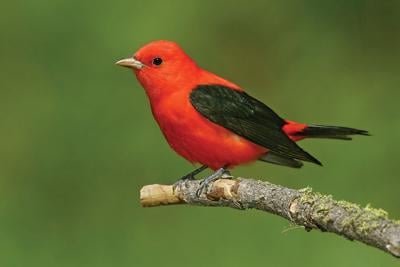The oak canopy had nearly closed in with new foliage, leaving dappled sunlight on the forest floor. Birdsong surrounded us and tiny clouds of insects were appearing. Above, we heard a distinctive “chick-brr,” then a raspy song.
We were frustrated for several minutes as we searched in vain for the songster. Then, a brilliant flash of red, and there he was — one of the brightest birds in the Eastern United States, the scarlet tanager.
Although he was about 50 feet overhead, the scarlet tanager (Piranga olivacea) was instantly recognizable. The male is startlingly red, with jet black wings, tail and eyes.
May is a glorious month for birding. Millions of migrants are joining resident birds in a tidal wave of song, nesting and breeding. The male scarlet tanager had just completed an arduous journey from South America, and he was exuberantly claiming territory and a mate. He had lots of company.
We were in the North Tract of the Patuxent Research Refuge near Laurel, MD. The land was once part of Fort Meade, the Army facility where countless soldiers trained. Today, its undisturbed forests are host to thousands of songbirds like the tanager.
The scarlet tanager concluded his singing, but we were able to keep him largely in view as he gleaned insects from his spot high in the treetops. A female was certainly somewhere nearby, perhaps feeding or starting to build a nest.
Female scarlet tanagers aren’t scarlet at all. She has a yellow-green body and head, and her wings are an olive brown. The cap is greenish, while the face and throat are a more distinct yellow than the body. Unusual among songbirds, the female also sings, usually a softer version of the male’s song, sung in response.
Tanagers typically eat insects during the summer. They glean bugs from the canopy, but will also eat wasps and the like on the wing. Upon arrival in the United States in the spring, they eat wherever they can find food to replenish energy lost in their long flight from South America. During this migration period, as well as in their winter territory, tanagers eat fruit and insects.
Most scarlet tanagers breed in the Eastern United States, with an estimated 7 percent raising broods farther north in Canada. They favor deciduous or mixed deciduous-evergreen forests, such as the pine-oak forests in the Chesapeake’s coastal plain habitat. Farther west and north, tanagers can be found in oak-hickory, beech and hemlock-hardwood tracts. They are sensitive to forest fragmentation, so look for them in undisturbed, larger woodlands.
The female builds a flimsy nest in three to four days high in a tree and distant from the trunk.
She incubates her single annual brood of three to five eggs for two weeks. The helpless chicks need another two weeks to fledge and a final two weeks of feeding help from their parents before they can manage on their own.
Despite their brilliant colors, scarlet tanagers are tough to spot. Because of their interior forest habitat and proclivity for life in the treetops, they are elusive. The best bet is to listen for the distinctive “chick-brr” call and look up for the telltale flash of red.
When the Army shifted its training functions in 1991, the surplus land became the North Tract of the Patuxent Refuge, thanks largely to the foresight of Maryland Sens. Paul Sarbanes and Barbara Mikulski.
The land serves as an excellent buffer to the original Patuxent Refuge property, especially the bird research and breeding programs. In addition to being a buffer, the land is an oasis of green in the densely populated Washington-Baltimore corridor, proving important ecological functions like carbon sequestration, oxygen production and watershed protection. As the forest regains its footing here, the location is well-managed for interior-dwelling species like tanagers.
The tract’s military history is still obvious. It has the dubious distinction of requiring visitors to sign a waiver exempting the Army of liability if a birder happens to step on a piece of unexploded ordinance. Fortunately, in its 25-year history as a refuge, neither bird nor birder has met such a tragic end.
Although we continued to watch the male tanager for some time, our attention was continually pulled away by the sounds and sights of other birds. A handsome American redstart caught my eye, then I was captivated by the fluted notes of a thrush.
Finally, our persistence paid off and we saw a female tanager, too. She wasn’t as flashy, but a lovely bird nonetheless. Sated for the day, we started back to the car, only to keep stopping to see “just one more.”
This lovely day offered both a plethora of birds and good advice: Keep looking for visions of unsurpassed beauty while treading softly to avoid the man-made hazards strewn along our way.

(0) comments
Welcome to the discussion.
Log In
We aim to provide a forum for fair and open dialogue.
Please use language that is accurate and respectful.
Comments may not include:
* Insults, verbal attacks or degrading statements
* Explicit or vulgar language
* Information that violates a person's right to privacy
* Advertising or solicitations
* Misrepresentation of your identity or affiliation
* Incorrect, fraudulent or misleading content
* Spam or comments that do not pertain to the posted article
We reserve the right to edit or decline comments that do follow these guidelines.